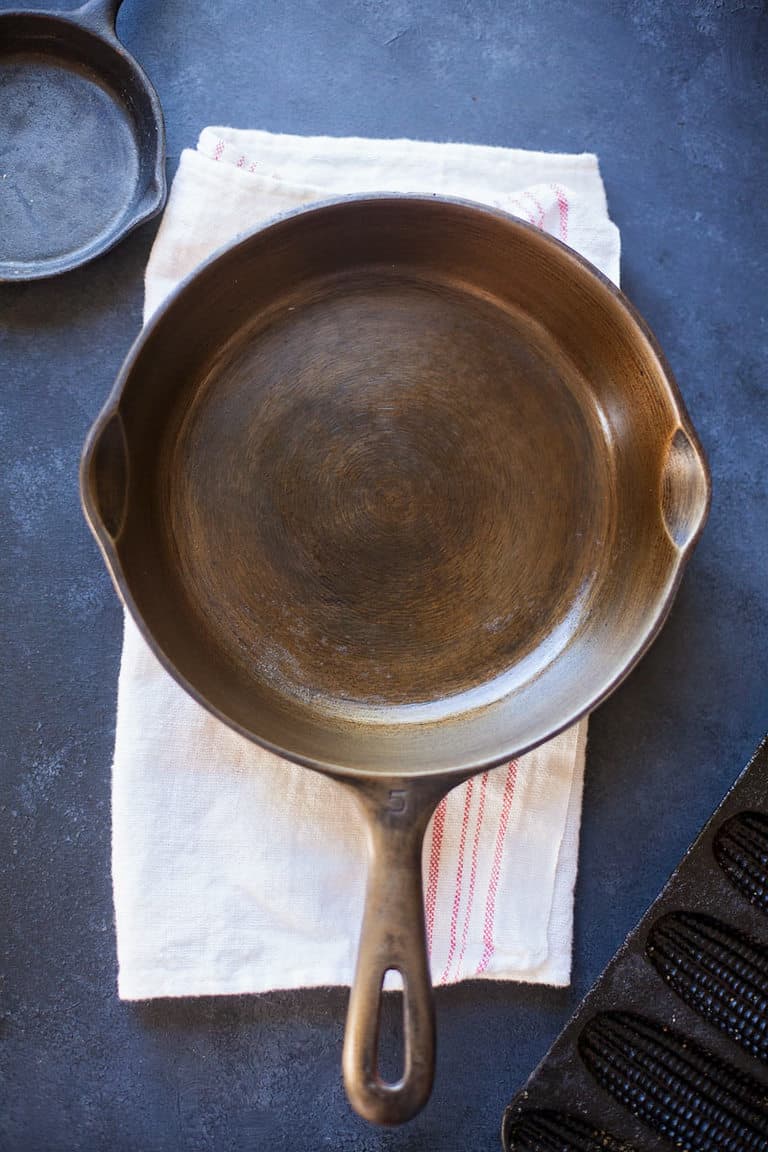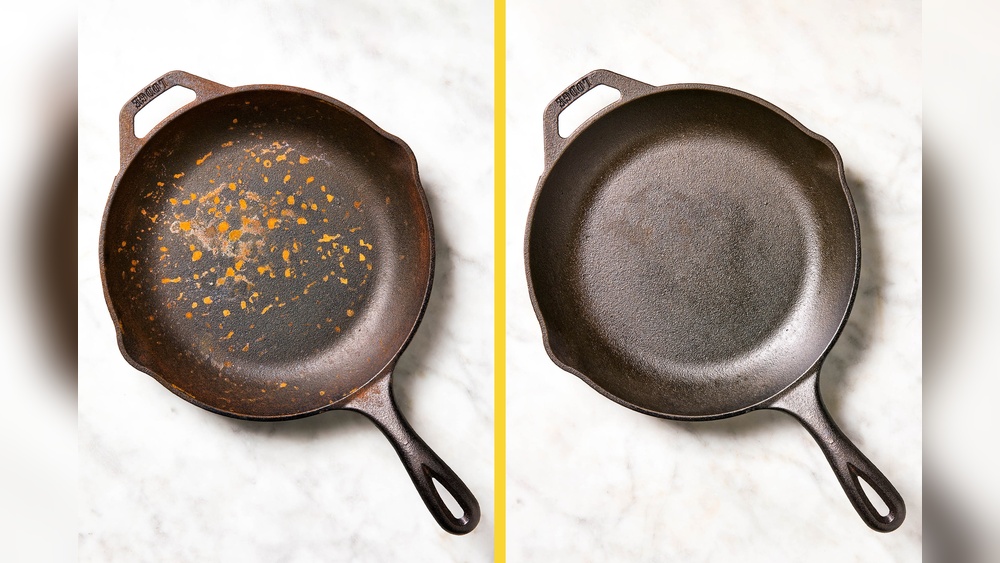Are you frustrated to see rust spots forming on your cast iron skillet? You take care of it, but still, those orange patches keep appearing.
It feels like all your effort to keep it seasoned and clean is going to waste. Why is your cast iron skillet rusting, and more importantly, how can you stop it for good? Keep reading, because understanding the simple reasons behind this problem will help you protect your skillet and make it last a lifetime.
You’ll learn easy tips that save your pan and bring back that perfect cooking surface you love.

Credit: www.reddit.com
Common Causes Of Rust
Rust on a cast iron skillet happens for a few common reasons. Understanding these causes helps keep your skillet in good shape. Skipping care steps can let rust form fast. Here are the main reasons rust appears on cast iron.
Exposure To Moisture
Water is the biggest enemy of cast iron. Leaving your skillet wet after washing invites rust. Storing it in damp places also causes rust to grow. Even small amounts of moisture can start the process. Dry your skillet fully after every use.
Inadequate Seasoning
Seasoning creates a protective layer on cast iron. Without enough seasoning, the metal is open to air and water. This layer stops moisture from touching the iron surface. If seasoning wears off or is thin, rust can form quickly. Regularly add oil and heat to keep this layer strong.
Improper Cleaning Methods
Using harsh soap or scrubbing with steel wool strips seasoning. This exposes bare iron to moisture and air. Soaking your skillet in water also damages the seasoning. Clean with a brush and hot water only. Re-season after cleaning to protect your pan.
Identifying Rust On Your Skillet
Rust on a cast iron skillet can damage its surface and affect cooking. Knowing how to spot rust early helps protect your skillet. Rust usually shows up as changes you can see and feel. These signs tell you that your skillet needs care.
Surface Appearance
Rust looks like red, orange, or brown spots on the skillet. These spots often appear rough and flaky. They can spread over time, covering more of the pan. The shiny black finish of a healthy skillet changes to dull or patchy. Rust can also cause small pits or holes to form.
Texture Changes
Rust makes the skillet surface feel rough instead of smooth. You might notice gritty or sandy patches on the pan. These areas may flake off when you touch or scrub them. The skillet might feel uneven or bumpy. These texture changes weaken the skillet’s cooking surface.
Quick Rust Removal Techniques
Rust on a cast iron skillet can appear quickly. Removing rust fast helps protect your pan. Several simple methods clean rust without special tools. These quick rust removal techniques restore your skillet’s surface safely.
Using Vinegar Soak
Vinegar dissolves rust effectively. Mix equal parts vinegar and water in a container. Submerge the skillet in the solution. Let it soak for one to two hours. Check the rust progress often. After soaking, scrub the skillet gently with a brush. Rinse well with water and dry immediately. This method works best for light to moderate rust.
Scrubbing With Steel Wool
Steel wool scrubs rust off quickly. Use fine or medium-grade steel wool. Rub the rusty spots firmly but carefully. Avoid scratching the skillet surface too much. Clean the pan with water after scrubbing. Dry the skillet right away to stop new rust. This technique suits small rust patches or spots.
Applying Baking Soda Paste
Baking soda is a mild abrasive for rust removal. Mix baking soda with water to form a thick paste. Spread the paste over rusted areas. Let it sit for 15 to 20 minutes. Use a soft brush or cloth to scrub the paste gently. Rinse the skillet thoroughly and dry it well. This method is gentle and good for light rust.
Re-seasoning Your Skillet
Rust on a cast iron skillet means the seasoning has worn off. Re-seasoning your skillet restores its protective layer. This stops rust and keeps food from sticking. The process is simple and can be done at home. It takes time but is worth the effort. Follow these steps to bring your skillet back to life.
Choosing The Right Oil
Pick an oil with a high smoke point. Flaxseed, grapeseed, or vegetable oil works well. Avoid oils that go bad quickly. These oils create a strong, durable coating. Use enough oil to cover the skillet thinly and evenly.
Oven Seasoning Process
Clean the skillet completely before starting. Dry it well to stop any moisture. Apply a thin layer of oil all over the pan. Place the skillet upside down in a hot oven at 450°F (232°C). Bake for one hour to let the oil bond with the metal. Turn off the oven and let the skillet cool inside. Repeat this process 2-3 times for best results.
Maintaining The Seasoning Layer
Clean your skillet with warm water and a brush only. Avoid soap and soaking the pan. Dry it immediately after washing. Apply a small layer of oil after each use. Store the skillet in a dry place to prevent moisture. Regular care keeps the skillet rust-free and smooth.
Daily Care Tips To Prevent Rust
Preventing rust on your cast iron skillet needs daily care. Small steps after each use keep your pan strong and ready. These habits stop moisture and air from causing rust. Follow these simple tips to protect your skillet every day.
Drying After Use
Always dry your skillet well after washing. Use a clean towel to wipe away water. Heat the pan on low stove heat for a few minutes. This removes any leftover moisture. Wet pans invite rust quickly. Drying fully keeps the pan safe.
Avoiding Soaking
Do not soak your cast iron in water. Soaking breaks down the protective seasoning layer. It also leaves the pan wet for too long. Clean the skillet with a brush or sponge instead. Quick washing keeps the pan dry and rust-free.
Proper Storage
Store your skillet in a dry place. Avoid leaving it in damp cabinets or near sinks. Place a paper towel inside the pan to absorb moisture. Keep the lid off or slightly open to let air flow. Good storage stops rust from forming.

Credit: www.thriftyartsygirl.com
When To Replace Your Skillet
Knowing when to replace your cast iron skillet protects your health and cooking quality. Rust can harm the skillet’s surface, affecting your food taste and safety. Small rust spots often clean off, but some damage cannot be fixed. Watch for signs that the skillet no longer cooks well or looks unsafe. These signs mean it is time to buy a new one.
Severe Rust Damage
Rust that covers most of the skillet is a big problem. It weakens the metal and changes how heat spreads. Deep rust pits create rough spots that trap food and germs. Cleaning will not fix deep rust or big rust patches. Using a skillet with severe rust can ruin meals and cause health risks. Replace the skillet if rust covers large areas or is hard to remove.
Cracks And Warping
Cracks in the skillet make it unsafe to use. Food and liquids can leak through cracks. Heat does not spread well on a warped pan. Warping causes uneven cooking and burnt spots. Cracks and warping often happen from dropping the skillet or heating it too fast. Once cracks or warping appear, the skillet loses its value and function. It is best to get a new skillet for safe cooking.

Credit: feastandfarm.com
Frequently Asked Questions
Why Does My Cast Iron Skillet Rust Quickly?
Cast iron rusts quickly when it’s exposed to moisture and air without proper seasoning. Moisture causes oxidation, leading to rust. Avoid soaking your skillet or leaving it wet. Always dry it thoroughly and apply a thin layer of oil after cleaning to protect the surface.
How Can I Prevent Rust On Cast Iron Skillets?
To prevent rust, clean your skillet promptly after use and dry it completely. Apply a light coat of cooking oil to maintain the seasoning. Store it in a dry place. Avoid soaking or putting it in the dishwasher, as excessive moisture promotes rust formation.
Can Rust Damage My Cast Iron Skillet Permanently?
Rust can damage your cast iron skillet if left untreated for long. Surface rust can be scrubbed off with a steel wool pad. Severe rust may require re-seasoning or professional restoration. Regular maintenance helps keep your skillet rust-free and extends its lifespan.
Is It Safe To Cook In A Rusty Cast Iron Skillet?
Cooking in a rusty skillet is not recommended. Rust can flake off into food, affecting taste and safety. Remove rust before cooking by scrubbing and re-seasoning the skillet. Proper care prevents rust and ensures safe, healthy cooking.
Conclusion
Rust on your cast iron skillet means it needs better care. Clean it gently and dry it well after each use. Apply a thin layer of oil to protect the surface. Store it in a dry place to stop moisture buildup.
Regular maintenance keeps your skillet strong and rust-free. With simple steps, your skillet will last many years. Keep cooking and enjoy the rich flavors cast iron offers.

